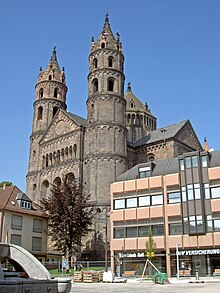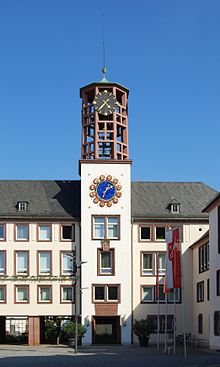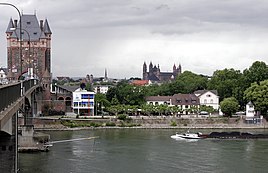
Back Worms Afrikaans Worms ALS ቩርምዝ Amharic Worms AN فورمس Arabic فورمس, المانيا ARZ Vorms Azerbaijani ورمس AZB Worms BAN Вормс Byelorussian
This article needs additional citations for verification. (May 2010) |
Worms | |
|---|---|
Nibelungen Bridge over the Rhine in Worms Medieval city center Christoffelturm | |
| Coordinates: 49°37′55″N 08°21′55″E / 49.63194°N 8.36528°E | |
| Country | Germany |
| State | Rhineland-Palatinate |
| District | Urban district |
| Government | |
| • Lord mayor (2018–26) | Adolf Kessel[1] (CDU) |
| Area | |
• Total | 108.73 km2 (41.98 sq mi) |
| Highest elevation | 167 m (548 ft) |
| Lowest elevation | 100 m (300 ft) |
| Population (2022-12-31)[2] | |
• Total | 84,646 |
| • Density | 780/km2 (2,000/sq mi) |
| Time zone | UTC+01:00 (CET) |
| • Summer (DST) | UTC+02:00 (CEST) |
| Postal codes | 67547–67551 |
| Dialling codes | 06241, 06242, 06246, 06247 |
| Vehicle registration | WO |
| Website | www |
| Official name | ShUM Sites of Speyer, Worms and Mainz |
| Type | Cultural |
| Criteria | (ii)(iii)(iv) |
| Designated | 2021 |
| Reference no. | [1] |


Worms (/vɔːrmz/; German pronunciation: [vɔʁms] ⓘ) is a city in Rhineland-Palatinate, Germany, situated on the Upper Rhine about 60 km (40 mi) south-southwest of Frankfurt am Main. It had about 84,646 inhabitants as of 2022[update].[3]
A pre-Roman foundation, Worms is one of the oldest cities in northern Europe. It was the capital of the Kingdom of the Burgundians in the early fifth century, hence is the scene of the medieval legends referring to this period, notably the first part of the Nibelungenlied.
Worms has been a Roman Catholic bishopric since at least 614, and was an important palatinate of Charlemagne. Worms Cathedral is one of the imperial cathedrals and among the finest examples of Romanesque architecture in Germany. Worms prospered in the High Middle Ages as an imperial free city. Among more than a hundred imperial diets held at Worms, the Diet of 1521 (commonly known as the Diet of Worms) ended with the Edict of Worms, in which Martin Luther was declared a heretic. Worms is also one of the historical ShUM-cities as a cultural center of Jewish life in Europe during the Middle Ages. Its Jewish sites (along with those in Speyer and Mainz) were inscribed on the UNESCO World Heritage List in 2021.[4]
Today, the city is an industrial centre and is famed as the origin of Liebfraumilch wine.[5] Its other industries include chemicals, metal goods, and fodder.
- ^ Wahl der Oberbürgermeister der kreisfreien Städte, Landeswahlleiter Rheinland-Pfalz, accessed 30 July 2021.
- ^ "Bevölkerungsstand 2022, Kreise, Gemeinden, Verbandsgemeinden" (PDF) (in German). Statistisches Landesamt Rheinland-Pfalz. 2023.
- ^ Statistisches Landesamt Rheinland-Pfalz, Bevölkerungsstand 2022, Kreise, Gemeinden, Verbandsgemeinden.
- ^ "ShUM Sites of Speyer, Worms and Mainz". UNESCO World Heritage Centre. Retrieved 2022-04-14.
- ^ Eric Pfanner (October 12, 2012). "After the Debacle Called Liebfraumilch". The New York Times. Retrieved April 15, 2024.









